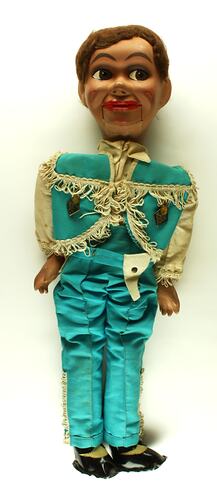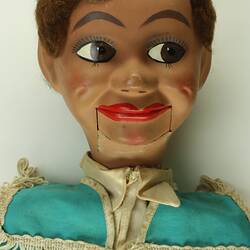Summary
Moulded plaster ventriloquist doll in the form of a boy, dressed in a cowboy costume.
It was manufactured in Melbourne by the Sterne Doll Company as part of a range of toys based on the TV ventriloquist doll Gerry Gee, star of Channel 9's `The Tarax Show', produced between 1958 and 1966. During the early 1960s they brought out Gerrys in several different costumes, including a cowboy ensemble. This was a popular play theme due to the large number of American westerns shown on TV in Australia.
Physical Description
Painted plaster doll with movable mouth mechanism, operated by a round metal ring and rod located inside back of shirt. Has a light brown mohair wig, painted plaster hands and stuffed cloth lower legs and feet. It is dress in a cowboy outfit, consisting of a white cotton shirt, with a press stud at collar, blue cotton pants, stapled at waist, blue cotton waistcoat, yellow cotton socks and black moulded laced shoes. The waistcoat and pants are decorated with white fringing, and there are two diamond shaped badges pinned onto either side of the front of the waistcoat.
Significance
This doll is significant as it represents the output of Melbourne toy manufacturer L.J. Sterne Doll Company. Leo Sterne arrived in Melbourne as a refugee from Austria in 1939 at the outbreak of World War II. Noticing a wartime shortage of imported dolls and toys in Melbourne, he began experimenting in his East Malvern garage with various forms of papier mache to produce partial and complete dolls. The enterprise was so successful that by 1946 the business was expanded to a full-scale factory in Carlton.
In 1958, Sterne was approached by TV ventriloquist Ron Blaskett, who performed on the children's program The Tarax Show on GTV Channel 9, to produce replicas of his doll 'Gerry Gee' for sale to the public. The 'Gerry Gee Junior' doll was born, and can be considered the first real example of television merchandising in Australia.
The doll was enormously popular, and in 1960 the 'Geraldine Gee' doll, Gerry's sister, was added to cater for female viewers. Throughout the early and mid 1960s several new styles of 'Gerry Gee Juniors' were produced to reflect contemporary fashions, interests and events. These included the Football Supporter, Cowboy and Cowgirl, Beatles Gerry, Space Gerry and Geraldine.
More Information
-
Collection Names
-
Collecting Areas
-
Acquisition Information
Donation from Mr Michael Reason, 17 Oct 2010
-
Manufacturer
Sterne Doll Company, 121-123 Leicester Street, Carlton, Greater Melbourne, Victoria, Australia, 1962
-
Person Depicted
Gerry Gee, 121-123 Leicester Street, Carlton, Greater Melbourne, Victoria, Australia, 1962-1965
-
Inscriptions
Printed on front of badges: Gerry Gee/ TARAX/ CLUB
-
Brand Names
-
Classification
-
Category
-
Discipline
-
Type of item
-
Overall Dimensions
220 mm (Width), 130 mm (Depth), 580 mm (Height)
-
Keywords
Australian Television Industry, Dolls, Performers, Television Publicity



